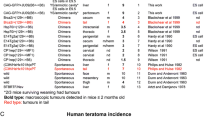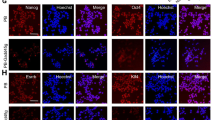Abstract
TGFβ family factors play an important role in regulating the balance of self-renewal and differentiation of mouse and human pluripotent stem and embryonic teratocarcinoma cells. The expression patterns of TGFβ family signaling ligands and functional roles of these signaling pathways differ significantly in mouse and human embryonic stem cells, but the activity and functional role of these factors in mouse and human embryonic teratocarcinoma cells were not sufficiently investigated. Comparative quantitative real-time PCR analysis of the expression of TGFβ family factors in mouse embryonic stem, embryonic germ, and embryonic teratocarcinoma cells showed that embryonic teratocarcinoma cells express lower ActivinA than pluripotent stem cells but similar levels of factors Nodal, Lefty1, TGFβ1, BMP4, and GDF3. In human nullipotent embryonic teratocarcinoma PA-1 cells, most factors of the TGFβ family (ACTIVINA, NODAL, LEFTY1, BMP4, and GDF3) are expressed at lower levels than in human embryonic stem cells. Thus, in mouse and human nullipotent teratocarcinoma cells, the expression of ActivinA is significantly reduced compared with embryonic stem cells. Presumably, these differences may be associated with changes in the functional activity of the respective signaling pathways and deregulation of proliferative and antiproliferative mechanisms in embryonic teratocarcinoma cells.
Similar content being viewed by others
References
Andrews, P.W., Damjanov, I., Simon, D., et al., Pluripotent embryonal carcinoma clones derived from the human teratocarcinoma cell line Tera-2. Differentiation in vivo and in vitro, Lab. Invest., 1984, vol. 50, pp. 147–162.
Andrews, P.W., Damjanov, I., Simon, D., et al., A pluripotent human stem-cell clone isolated from the TERA-2 teratocarcinoma line lacks antigens SSEA-3 and SSEA-4 in vitro, but expresses these antigens when grown as a xenograft tumor, Differentiation, 1985, vol. 29, pp. 127–135.
Andrews, P.W., Human teratocarcinomas, Biochim. Biophys. Acta, 1988, vol. 948, pp. 17–36.
Brons, I.G.M., Smithers, L.E., Trotter, M.W.B., et al., Derivation of pluripotent epiblast stem cells from mammalian embryos, Nature, 2007, vol. 448, pp. 191–195.
Caisander, G., Park, H., Frej, K., et al., Chromosomal integrity maintained in five human embryonic stem cell lines after prolonged in vitro culture, Chromosome Res., 2006, vol. 14, pp. 131–137.
Dreesen, O. and Brivanlou, A.H., Signaling pathways in cancer and embryonic stem cells, Stem Cell Rev., 2007, vol. 3, pp. 7–17.
Eiselleova, L., Matulka, K., Kriz, V., et al., A complex role for FGF-2 in self-renewal, survival, and adhesion of human embryonic stem cells, Stem Cells, 2009, vol. 27, pp. 1847–1857.
Gordeeva, O.F., Lifantseva, N.V., and Nikonova, T.M., Regulation of in vitro and in vivo differentiation of mouse embryonic stem cells, embryonic germ cells and teratocarcinoma cells by TGFβ family signaling factors, Russ. J. Dev. Biol., 2009, vol. 40, no. 6, pp. 325–338.
Gordeeva, O.F., Lifantseva, N.V., and Khaidukov, S.V., Expression patterns of germ line specific genes in mouse and human pluripotent stem cells are associated with regulation of ground and primed state of pluripotency, Russ. J. Dev. Biol., 2011, vol. 42, no. 6, 355-376.
Gore, A., Li, Z., Fung, H., et al., Somatic coding mutations in human induced pluripotent stem cells, Nature, 2011, vol. 471, pp. 63–67.
Greber, B., Lehrach, H., and Adjaye, J., Fibroblast growth factor 2 modulates transforming growth factor beta signaling in mouse embryonic fibroblasts and human ESCs (hESCs) to support hESC self-renewal, Stem Cells, 2007, vol. 25, pp. 455–464.
Greber, B., Lehrach, H., and Adjaye, J., Control of early fate decisions in human ES cells by distinct states of TGFbeta pathway activity, Stem Cells Dev., 2008, vol. 17, pp. 1065–1077.
Hovatta, O., Jaconi, M., Töhönen, V., et al., A teratocarcinoma-like human embryonic stem cell (hESC) line and four hESC lines reveal potentially oncogenic genomic changes, PLoS One, 2010, vol. 5, p. e10263.
Lifantseva, N.V., Koltsova, A.M., Poljanskaya, G.G., and Gordeeva, O.F., Expression of TGFβ family factors and FGF2 in mouse and human embryonic stem cells maintained in different culture systems, Russ. J. Dev. Biol., 2013, vol. 44, no. 1, pp. 7–18.
Martin, G.R. and Evans, M.J., Differentiation of clonal lines of teratocarcinoma cells: formation of embryoid bodies in vitro, Proc. Natl. Acad. Sci. USA, 1975, vol. 72, pp. 1441–1445.
Na, J., Furue, M.K., and Andrews, P.W., Inhibition of ERK1/2 prevents neural and mesendodermal differentiation and promotes human embryonic stem cell selfrenewal, Stem Cell Res., 2010, vol. 5, pp. 157–169.
Nichols, J. and Smith, A., Naive and primed pluripotent states, Cell Stem Cell, 2009, vol. 4, pp. 487–492.
Niwa, H., How is pluripotency determined and maintained?, Development, 2007, vol. 134, pp. 635–646.
Oshimori, N. and Fuchs, E., The harmonies played by TGF-β in stem cell biology, Cell Stem Cell, 2012, vol. 11, pp. 751–764.
Papaioannou, V.E., Gardner, R.L., McBurney, M.W., et al., Participation of cultured teratocarcinoma cells in mouse embryogenesis, J. Embryol. Exp. Morphol., 1978, vol. 44, pp. 93–104.
Rossant, J. and McBurney, M.W., The developmental potential of an euploid male teratocarcinoma cell line after blastocyst injection, J. Embryol. Exp. Morphol., 1982, vol. 70, pp. 99–112.
Smith, A.G., Heath, J.K., Donaldson, D.D., et al., Inhibition of pluripotential embryonic stem cell differentiation by purified polypeptides, Nature, 1988, vol. 336, pp. 688–690.
Smith, J.R., Vallier, L., Lupo, G., et al., Inhibition of Activin/Nodal signaling promotes specification of human embryonic stem cells into neuroectoderm, Dev. Biol., 2008, vol. 313, pp. 107–117.
Tesar, P.J., Chenoweth, J.G., Brook, F.A., et al., New cell lines from mouse epiblast share defining features with human embryonic stem cells, Nature, 2007, vol. 448, pp. 196–199.
Urbach, A. and Benvenisty, N., Studying early lethality of 45, XO (Turner’s syndrome) embryos using human embryonic stem cells, PLoS One, 2009, vol. 4, p. e4175.
Vallier, L., Alexander, M., and Pedersen, R.A., Activin/Nodal and FGF pathways cooperate to maintain pluripotency of human embryonic stem cells, J. Cell Sci., 2005, vol. 118, pp. 4495–4509.
Vallier, L., Touboul, T., Chng, Z., et al., Early cell fate decisions of human embryonic stem cells and mouse epiblast stem cells are controlled by the same signalling pathways, PLoS One, 2009, vol. 4, p. e6082.
Xu, C., Inokuma, M.S., Denham, J., et al., Feeder-free growth of undifferentiated human embryonic stem cells, Nat. Biotechnol., 2001, vol. 19, pp. 971–974.
Xu, R., Chen, X., Li, D.S., et al., Bmp4 initiates human embryonic stem cell differentiation to trophoblast, Nat. Biotechnol., 2002, vol. 20, pp. 1261–1264.
Xu, R., Peck, R.M., Li, D.S., et al., Basic FGF and suppression of bmp signaling sustain undifferentiated proliferation of human es cells, Nat. Methods, 2005, vol. 2, pp. 185–190.
Zeuthen, J., Nørgaard, J.O., Avner, P., et al., Characterization of a human ovarian teratocarcinoma-derived cell line, Int. J. Cancer, 1980, vol. 25, pp. 19–32.
Author information
Authors and Affiliations
Corresponding author
Additional information
Original Russian Text © O.F. Gordeeva, 2014, published in Ontogenez, 2014, Vol. 45, No. 4, pp. 272–279.
Rights and permissions
About this article
Cite this article
Gordeeva, O.F. Low expression of activin a in mouse and human embryonic teratocarcinoma cells. Russ J Dev Biol 45, 224–230 (2014). https://doi.org/10.1134/S1062360414040043
Received:
Accepted:
Published:
Issue Date:
DOI: https://doi.org/10.1134/S1062360414040043




